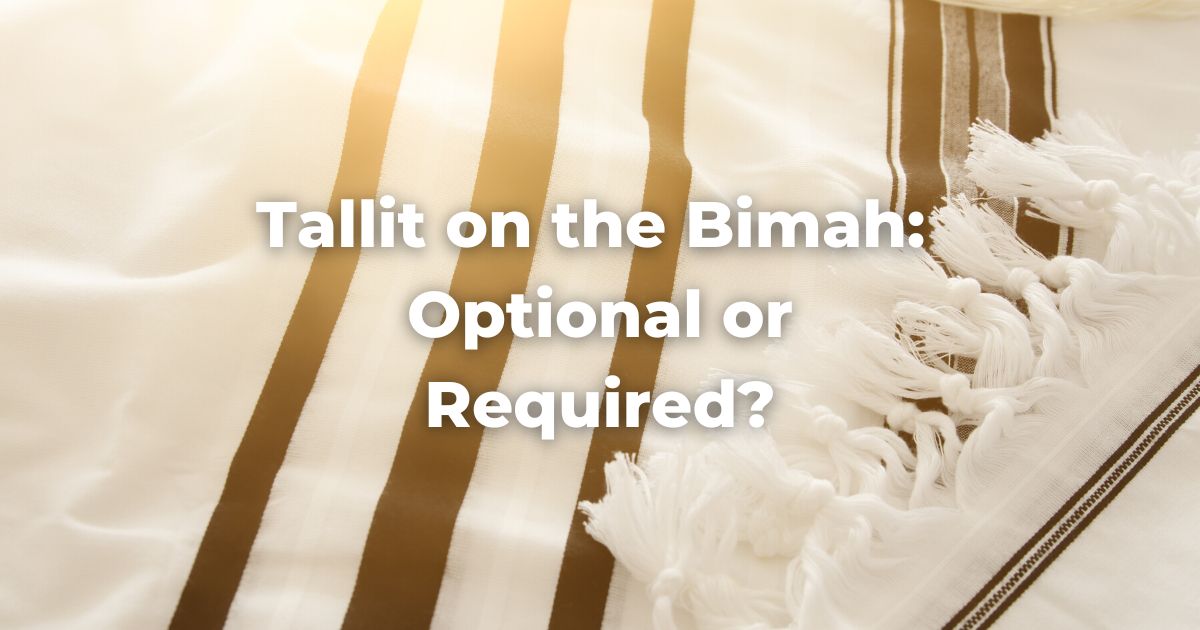Should individuals wear a tallit (prayer shawl) on the bima when leading services, reading Torah, or called to the Torah for an aliyah?
This teshuva addresses the question of “whether those who for some reason do not wear a tallit for their private worship should nevertheless don one to play a public role in leading prayer.”
Ultimately, the decision made by the Committee on Jewish Law and Standard is that all people on the bimah in a leadership capacity should wear a tallit, as well as during personal morning prayers.
Rabbi Miriam Berkowitz explores how and why the committee came to this decision, as well as how, why, when, and where to wear a tallit. This decision expands upon Pamela Barmash’s teshuva on Women and Mitzvot.
Symbolism of Tallit
With various references requiring four-cornered garments to have fringes, called tzitzit (Numbers 15:38-40, Deuteronomy 22:12), where and when to wear tzitzit has constantly been a subject of discussion. But as fashion changed, “the tallit was recast as a prayer specific garb [rather than a daily garment] and it became assumed that people would make the effort to wear it,” wrote Rabbi Berkowitz.
The use of the tallit took on a few meanings, including to serve as a physical preparation for prayer and dressing respectfully for the environment.
Wearing a tallit is a way to “set aside daily concerns and shift one’s focus to the prayer experience”—it can be a transition between regular life and a moment of prayer.
This physical element to our prayer can enhance the presence and demeanor of the person representing the community when leading prayer, shaping the feel of the community.
Rabbi Berkowitz does note that, “the prayer leader’s wearing of a tallit does not stem from the obligation to wear tzitzit, rather is a matter of honor for the community, as mentioned in the TalmudReferring to one of two collections, the Jerusalem and Babylonian Talmuds, edited in the 6th century, that contains hundreds of years of commentary, discussion, and exploration of the ideas in the Mishnah. One could describe it as Mishnah + Gemara = Talmud Read more Tractate Rosh Hashanah 17b.”
Magen Avraham 18:2 and MishnaA collection of rabbinic teachings edited in Israel around 225 CE. Organized in six sedaraim by subject matter and dealing with both ritual and civil law. Both the Jerusalem and Babylonian Talmud are expansive discussions of the Mishnah. Read more Berura 18:5 both explain that a prayer leader must wear a tallit, unless that is not the custom of the community.
Rabbi Berkowitz also writes, “Dressing respectfully, with a tallit, is expected for one who is even temporarily in a public religious role.”
Why Some Might Not Wear or Want to Wear a Tallit
While regarded as a “men’s mitzvah,” some may feel disconnected from the practice of wearing tallit based on gender and custom, rather than halakhic rationale.
According to Menahot 43a, there is a majority opinion that women are obligated to wear tzitzit. Rambam (Mishneh TorahRefers to the first five books of the Hebrew Bible, the Tanakh, also called the Five Books of Moses, Pentateuch or the Hebrew equivalent, Humash. This is also called the Written Torah. The term may also refer to teachings that expound on Jewish tradition. Read more, Laws of Fringes 3:9) explains that it is not forbidden for women to wear tizitzit but that they are exempt.
Despite these opinions, this was most likely not the widespread norm. Rabbi Berkowitz expands: “even in traditionally rabbinic cultures in which there was a higher percentage of economically autonomous women who performed mitzvot with blessings, there was opposition to women wearing a tallit.”
She goes on to say that contemporary women, serving as full members of their communities and societies “need the beneficial effects of wearing a dignified tallit in front of God just as much as men do, to enhance their prayer experience.” And the congregation should see their leaders perform rituals in dignity.
Ultimately, she writes,
“When women are considered respected and full members of the civil community, it does not make sense to limit their ritual involvement, for educational, spiritual, and social reasons. … Furthermore, boys in Jewish schools and summer camps may be reluctant to adopt Jewish rituals if girls do not have to do these mitzvot and the girls may continue to feel less than fully participating members if some mitzvot are still considered optional.”
Why Decide to Wear a Tallit on the Bimah?
To begin to answer this question, it should be known that the Conservative movement holds that women should be obligated in all mitzvot, even the ones they were considered to be exempt from previously.
In answering this question—when a tallit should be worn on a bimah—women wearing tallitot must also be addressed. While there is a consistent practice in regards to wearing a tallit for men, for women the practice can be very inconsistent.
The customs in consideration for women can vary greatly, and may reflect a root in, “ideological opposition as well as lack of personal familiarity with the custom, even though it may seem logically inconsistent.” This is not to say, however, that inconsistency does not exist for men and consistency does not exist for women.
This is also not to say that this question is only relevant for those that fit into heteronormative categories. This aspect of our movement—obligation in mitzvot—holds for everyone, equally.
This teshuva is seeking to express an opinion on making a policy regarding all congregants and when to wear a tallit. Rabbi Berkowitz and the CLJS are concerned “with addressing the needs of communities grappling with these questions and seeking uniformity of practice.”
Rabbi Berkowitz also writes, “We maintain that if a woman is comfortable leading parts of the service she should do it in the manner consistent with the community’s standards and use a tallit, according to Rabbi [Pamela] Barmash’s ground-breaking teshuva.”
See more: (Women and Mitzvot by Rabbi Pamela Barmash)
“Women have been able to participate in the service for decades, and yet tallit is still very uncommon. We wish to emphasize this mitzvah and not wait yet another generation to make it more mainstream,” Rabbi Berkowitz explains.
Saying a Blessing Over a Tallit
There are mutliple occasions when one should and should not say a blessing when putting on a tallit.
Rambam (Mishneh Torah, Laws of Tzitzit 3:9) says that when wearing tzitzit for personal use, a blessing is not appropriate. Rabbeinu Tam (Tosafot Rosh Hashanah 33a) says that a blessing is appropriate in this situation.
Additionally, Rabbi Berkowitz writes that a person must “own” the tallit in order to say the brakha, according to the halakha. This can be accomplished “by owning one’s tallit, borrowing it with the understanding it is a temporary gift, or borrowing it from the synagogue’s tallitot for public use, which are there with the explicit understanding that they ‘belong’ to anyone who takes them.”
If a tallit is worn for the sake of respecting and dignifying the mitzvah in leading and not for personal use, a blessing may not be necessary—the tallit is being used as a garment to be dressed with dignity, rather than for the use of the tzitzit (M. Brura OH 14:11, Shulhan Arukh, OH 8, Mishna Brura 14:11). Alternatively, others argue that a blessing should be said over the tallit because the leader is going to be representing the community.
Conclusion
The tallit, and subsequently tzitzit, have multiple functions including:
- reminding us of God’s presence, guidance, and care
- reminding us of the mitzvot and encouraging us to keep them (Numbers 15:37-41)
- serving as a connection with the traditionally dignified garb of our biblical ancestors and the traditional garb of our more recent generations
- fulfilling a commandment
- transitioning from mundane to sacred time and space
All post-B’ Mitzvah adults should wear a tallit while davening; this enhances the prayer experience and “ideally, they should commit to davening daily and wearing it every time they daven [in the morning].”
In terms of the question of wearing a tallit for an honor on the bimah, “all Jewish adults eligible for honors will be wearing tallit already.”
In other cases, the concepts of “kvod haTorah” (respect for the Torah) and “kvod hatzibbur” (respect for the congregation) should be invoked and a tallit should be donned for honors. This is for the visual and emotional experience of the service and “makes the honorees seem like full not partial members of the community.”
Ruling
“A tallit gadol should be worn by all Jews over bar/bat mitzvah age [for their personal morning prayers and] when called upon to lead services or participate in the Torah service.
Even those [unmarried men and women] individuals who continue their family custom not to wear a tallit gadol in their private prayers should put one on when called upon to lead communal prayers or to participate in the Torah service and say the appropriate blessing.
Although a period of adjustment to this more expansive practice may be necessary in many communities and synagogues will have to determine their policy on their issue, our ideal is for all Jews past the age of bar mitzvah to participate in this mitzvah which symbolizes awareness of the divine presence, and acceptance of the commandments.
Day schools, Hebrew schools, synagogues and camps which have the opportunity to train the next generation have a special role in encouraging this observance for all, based on the principles of egalitarianism, kvod haTorah, kvod hatzibbur and hinukh (education).”
This article has been adapted from Rabbi Berkowitz’s teshuvah.
You can read the entire teshuva here.
Author
-

Reena Bromberg Gaber is a student in the Joint Program with Columbia University and the Jewish Theological Seminary. At school, she is involved with Columbia/Barnard Hillel, Gamma Phi Beta, the Columbia Daily Spectator, and Artists Reaching Out. Growing up, Reena was involved with the Conservative movement, including many summers as a camper and staff member at Camp Ramah in the Poconos and in local, regional, and international leadership positions in USY. As Reena moves through college and into adulthood, she is excited to find a space for herself and her peers in the Conservative movement.
View all posts





